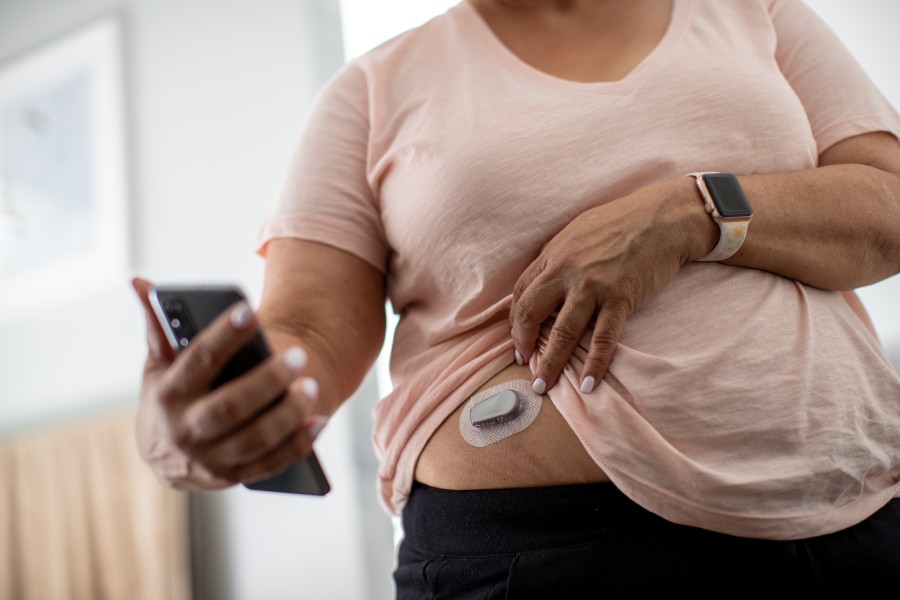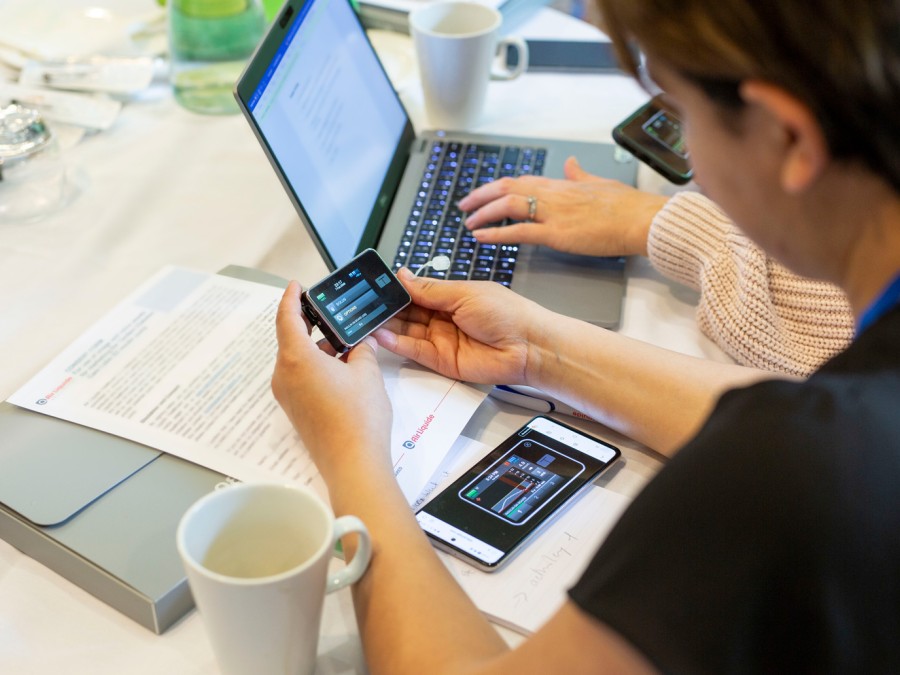What Is A Continuous Glucose Monitor (CGM)?

What Is A Continuous Glucose Monitor (CGM)?
You may have heard about continuous glucose monitors (CGM) and wondered what they are and whether they might be right for you.
This article will explain what they are, how they work, and whether they might help you manage your diabetes.
What is a CGM?
CGM stands for continuous glucose monitor or continuous glucose monitoring.
If you’ve been diagnosed with diabetes, one of the first things that your healthcare team will tell you about is monitoring your blood glucose levels. Self-monitoring is one of the cornerstones of careful diabetes care.
Self-monitoring, via finger-prick testing, allows you to measure what your blood glucose is at any given time and, importantly, helps you learn what causes it to go up or down.
Self-monitoring is not without its difficulties. Some cannot perform the finger-prick testing themselves, others may find the multiple finger-prick testing to be uncomfortable or painful. The intermittent nature of the self-administered testing means that there can be significant periods of time (for instance, while you are asleep) where your blood glucose is not monitored.
Continuous glucose monitoring (CGM) seeks to work around many of these problems, providing a convenient and comprehensive assessment of blood glucose levels, which may allow you greater management of your diabetes.
CGM systems measure glucose levels in the interstitial fluid (the fluid which surrounds the fatty tissue), providing semi-continuous information about your glucose levels. This can help to identify and prevent unwanted periods of hypo- and hyperglycaemia.
How does CGM work?
A CGM consists of a number of parts. The first of these is a water-resistant disposable sensor that sits just below the skin, usually on the upper arm or abdomen. This sensor measures the glucose in the fluid that surrounds it (known as the interstitial fluids).
This measurement is sent to the second part of the CGM, which is the transmitter. The transmitter then sends and/or stores this signal wirelessly (or otherwise) to the receiver/display.
The display device for most modern CGMs can display your current blood glucose, store previous readings, and help you to understand how activities such as eating or exercise might affect your blood glucose levels, as well as how to manage these effects.
The sensor portion of the CGM is disposable and needs to be changed every 3 -14 days. The transmitter and display components are reused with your next sensor to allow you to maintain continuous monitoring.
Who can use a CGM?
Most people using CGMs have type 1 diabetes, although evidence suggests that there may be benefit for people with type 2 diabetes to use continuous glucose monitoring.
Continuous glucose monitoring may be good for:
-
Those who cannot perform finger-prick testing themselves (e.g. children)
-
People who may need tighter glucose control than usual (e.g. when pregnant)
-
People who are unaware of having a hypoglycaemic episode
If you aren’t sure whether you can — or should — use a CGM system, talk to your diabetes care team for further guidance.
Can I use a CGM and an insulin pump together?
An insulin pump (also known as a continuous subcutaneous insulin infusion or CSII) is a device that some people use to provide their body with the insulin it needs to manage their blood glucose.
An insulin pump usually provides a continuous low dose of insulin (sometimes called a basal dose) which can be temporarily increased (a bolus dose) in response to eating, exercising, or to readings of a glucose monitor.
The measurement of blood glucose is usually undertaken in the classic way, by taking repeated finger-prick blood tests which are measured using a traditional glucose meter.
This system can be changed by introducing a CGM, allowing the person to give doses of insulin based on a continuous glucose reading, rather than intermittent finger-pricks.
What is an artificial pancreas?
To understand an artificial pancreas, it may be helpful to briefly think about what your actual pancreas does, and how it is affected in type 1 diabetes.
When you eat, your food is digested and carbohydrates are broken down into simpler sugars, such as glucose, which are absorbed into your blood. Your pancreas detects these elevated blood glucose levels and secretes a hormone called insulin to bring your blood glucose levels back to the normal level. In type 1 diabetes, damage to your pancreas stops it from secreting enough insulin to manage your blood glucose.
An artificial pancreas seeks to emulate the function of a real pancreas by measuring blood glucose and then adjusting the rate of insulin being given as a continuous infusion into the body.
An artificial pancreas consists of a continuous glucose monitor connected to an insulin pump. The pump uses information from the CGM and an algorithm to adjust the rate of the insulin infusion.
Studies have shown that pumps that run in this manner can lead to improved glucose control when compared to conventional pumps.
Modern systems can also react to issues such as hypoglycaemia by reducing or temporarily stopping the insulin infusion.
Sources
- Ajjan, R., Slattery, D. & Wright, E. “Continuous Glucose Monitoring: A Brief Review for Primary Care Practitioners.” Adv Ther 36, 579–596 (2019).
- Mathew TK, Tadi P. “Blood Glucose Monitoring.” [Updated 2021 Aug 11]. In: StatPearls [Internet]. Treasure Island (FL): StatPearls Publishing; 2022 Jan-.
- Langendam M, Luijf YM, Hooft L, DeVries JH, Mudde AH, Scholten RJPM. “Continuous glucose monitoring systems for type 1 diabetes mellitus.” Cochrane Database of Systematic Reviews (2012), Issue 1. DOI:10.1002/14651858.CD008101.pub2.
- David C. Klonoff. “Continuous Glucose Monitoring: Roadmap for 21st century diabetes therapy.” Diabetes Care 1 May 2005; 28 (5): 1231–1239.
- Klemen Dovc, Tadej Battelino. “Evolution of Diabetes Technology” Endocrinology and Metabolism Clinics of North America, 2020; 49(1), 1-18.
- “Diabetes (type 1 and type 2) in children and young people: diagnosis and management.” NICE guideline NG18/ Published: 201. Last updated: 2020
- “Type 1 diabetes in adults: diagnosis and management.” NICE guideline [NG17] Published: 26 August 2015. Last updated: 21 July 2021
- “Diabetes in pregnancy: management from preconception to the postnatal period.” NICE guideline [NG3] Published: 25 February 2015. Last updated: 16 December 2020




